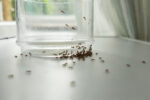
Asian Termites are Killing South Florida’s Pine Trees
As if invasive Asian subterranean termites weren’t causing enough harm to homes and businesses in South Florida with their super-sized colonies and voracious appetites, the Sun-Sentinel reported in an April 24 article that now these aggressive termites are chowing down on South Florida pine trees. According to the Sun-Sentinel, a University of Florida (UF) research team just published a study in Florida Entomologist that zeroes in on the destruction of native slash pines in Ft. Lauderdale. Thomas Chouvenc, assistant professor of urban entomology at the UF’s Institute of Food and Agricultural Sciences, led the study that examined 400 slash pines in residential areas and parks in the Ft. Lauderdale area.
Asian termites are infesting live pine trees
What the team found raises concerns for native Florida trees that have provided shade, oxygen and wildlife habitats for South Florida’s tropical bird populations and other animals, for over a century. The study revealed that over the past five years, 12% of the slash pines in the residential areas and 3% in the city’s parks surveyed were killed by Asian termites. Chouvenc warned that these aggressive termites are on course to cause deadly damage here and in Miami-Dade County, Palm Beach County, and parts of Broward County if left to their own devices. “The clock is ticking on most of our slash pines in greater Fort Lauderdale,” he said. “I think we’re on the way to irreversibly lose most of these slash pines if we don’t do anything.”
Non-native Asian termites swarm at night
Most South Florida homeowners are familiar with Asian and Formosan subterranean termites. Both species of subterranean termites have been making headlines as they ravage homes and businesses in search of food for their growing populations. Far more aggressive than native termites, Asian termites are yellowish-brown and about one-half inch long, with colonies consisting of over a million members.
Where did these Non-native Asian termites get here?
Southeast Asia natives, Asian termites were probably introduced to South Florida as stowaways on cargo ships and yachts, according to most sources. The first reported sightings in the US occurred in Miami in 1996 as well as Ft. Lauderdale and Riviera Beach in 2005. Building extensive colonies underground, new Asian termite colonies are established when swarms of reproductive alates take flight on spring nights in search of mates. These newly formed pairs then burrow into trees and houses to start growing their own colonies. Chouvenc indicated that the park trees may have been spared from more Asian termites than residential trees because Asian termites swarming at night are attracted to the lights in residential areas.
Slash pine – one of South Florida’s signature trees
Slash pines, one of old South Florida’s most distinctive trees, gets their name from the slashes cut at angles into their trucks in order to extract sap or resin. Extracting pine resin or sap for waterproofing boats and making turpentine was at one time a major component of the southern economy. As a popular, sturdy building material, known as Dade County pine, many older slash pine homes in South Florida have weathered a century of hurricanes. Slash pines were “one of the original canopy trees in the area,” said Michael Orfanedes, Broward County extension agent for commercial horticulture. “They’re just a fraction of what they were originally because of development. They’re famous for harboring birds in their hollows.” Slash pines grew in rockland habitats where the dry land was much sought after by real estate developers. This development considerably reduced slash pine populations, resulting in slash pines scattered through parks and neighborhoods.
Asian termites slowly starve trees
Because termites can’t eat the dead tissue in the sappy, inner wood, or believe us, they would, the termites attack the live tissue on the outer layers of the trunk. Eating the wood in the trunks of slash pines severs tubes that transport nutrients, such as sugar, to the live tree. The tree slowly starves as its vascular system is cut off or disabled. To make matters worse, the UF study also revealed that Asian termites are not terribly picky eaters, as a number of other trees that make up the South Florida urban canopy show signs of infestations, in particular, live oaks.
Live oak and other tree losses could be devastating in a direct hit by a hurricane
Elegant and massive live oaks, a grand feature of the southern landscape, by design, have withstood hurricanes through the years. Asian termites, while not killing these graceful giants, hollow them out, weakening them in storms. Due to their hollowed-out insides, three live oaks in Broward County perished when Hurricane Irma glanced by Broward County. Chouvenc said that these live oaks would have survived if they had not been affected by Asian termites. The UF researcher also said that due to the fact that so many trees have been affected by Asian termites, “a direct hit would have been that much more devastating.” Chouvenc pointed out that since Wilma in 2005, the area hasn’t been hit by a major hurricane, “so it’s been 12 or 13 years of damage that’s been piling up in these trees.”
Further research is needed to assess the threat of Asian termites on our tree population
According to the Sun-Sentinel, the Florida Department of Agriculture and Consumer Services, Asian termite activity in live trees may pose a serious threat but Mark Torok, senior forester said Asian termites may be a serious threat but that further research is needed. “It’s definitely something we shouldn’t ignore,” he said. “But we don’t have a full understanding yet about this pest. Are they attacking weakened trees or are they attacking healthy trees? How aggressive are they? How much damage do they do? Does it like any tree more than others?”
Area-wide management and collective consciousness efforts may be necessary
Chouvenc suggested that even though pest control companies can eliminate colonies on a house-to-house basis, if increasing structural damage is occurring in infested neighborhood trees, area-wide management could be a necessary solution, with entire neighborhoods cooperating, in addition to a “collective consciousness that maybe we have to do something on a larger scale than protecting our tiny half acre.”
Wondering if your trees are infested?
- Homeowners can peel back a piece of dead outer bark to check for termites.
- Cutting infested trees won’t get rid of your Asian termites, as they live underground.
- Tenting isn’t a viable solution, as again, most of the colony lives underground.
- Contacting a professional pest control company is your most sensible solution.
Hulett’s Healthy Home approach
Termites, especially aggressive invasive species such as Asian and Formosan termites, should be handled by a trusted pest control professional. Hulett Environmental Services, a family-owned business with over 50 years of termite expertise in the South Florida area, offers a free termite inspection along with a wide range of solutions for your termite concerns. Our licensed and certified technicians assess your termite situation and develop a plan to eliminate termites from your home and property. Because subterranean termites live in extensive colonies under the ground outside your home, strategic placement of a non-repellant liquid that worker termites transport from the infested area back to their nests works effectively and quickly to kill queens and destroy colonies. The very best way to fight termites is to prevent them from entering your home at all. Our Annual Termite Renewal Program wards off would-be invaders and we’re so sure of our Total Termite Protection Program that we offer a million dollar guarantee you’ll be satisfied with our services. Eliminate the stress of worrying about termites damaging your home and your trees. Just call Hulett!



